Interannual Variations of Rainfall in Late Spring over Southwest China and Associated Sea Surface Temperature and Atmospheric Circulation Anomalies
Abstract
:1. Introduction
2. Data and Methods
2.1. Data
2.2. Method
3. Leading Patterns of Rainfall Variation in Late Spring and Related Atmospheric Characteristics in Southwest China
4. Physical Mechanism Analysis
4.1. The Role of Tropical Sea Surface Temperature
4.2. The Role of Mid-High Latitude Circulation Systems
5. Conclusions and Discussion
Author Contributions
Funding
Institutional Review Board Statement
Informed Consent Statement
Data Availability Statement
Acknowledgments
Conflicts of Interest
References
- Ding, T.; Gao, H. The record-breaking extreme drought in Yunnan Province, Southwest China during spring–early summer of 2019 and possible causes. J. Meteorol. Res. 2020, 34, 997–1012. [Google Scholar] [CrossRef]
- Ma, S.; Zhu, C.; Liu, B. Possible causes of persistently extreme-hot-days-related circulation anomalies in Yunnan from April to June 2019. Chin. J. Atmos. Sci. 2021, 45, 165–180. (In Chinese) [Google Scholar]
- Zheng, J.; Zhang, W.; Ma, T.; Zhao, J. Composite characteristics of the abnormal circulation in May between extreme drought years and rainy years of Yunnan. Plateau Meteorol. 2014, 33, 916–924. (In Chinese) [Google Scholar]
- Chen, Y.; Ding, Y. Cold air activity in July 2004 and its impacts on intense rainfalls over Southwest China. Acta Meteorol. Sin. 2006, 64, 743–759. (In Chinese) [Google Scholar]
- Xia, Y.; Wan, X.; Yan, X.; Wu, L.; Long, Y. Variations of spring precipitation over southwest China and characteristic circulations for precipitation anomalies. Acta Meteorol. Sin. 2016, 74, 510–524. (In Chinese) [Google Scholar]
- Xiang, B.; Zhou, J.; Li, Y.H. Asymmetric relationships between El Niño/La Niña and floods/droughts in the following summer over Chongqing, China. Atmos. Ocean. Sci. Lett. 2020, 13, 171–178. [Google Scholar] [CrossRef] [Green Version]
- Li, G.; Chen, J.; Wang, X.; Luo, X.; Yang, D.; Zhou, W.; Tan, Y.; Yan, H. Remote impact of North Atlantic sea surface temperature on rainfall in southwestern China during boreal spring. Climate Dyn. 2018, 50, 541–553. [Google Scholar] [CrossRef]
- Jiang, X.W.; Li, Y.Q. Spatio-temporal variability of winter temperature and precipitation in Southwest China. J. Geogr. Sci. 2011, 21, 250–262. [Google Scholar] [CrossRef]
- Yan, H.; Duan, X.; Cheng, J. Study on a severe drought event over Yunnan in Spring 2005. J. Trop. Meteorol. 2007, 23, 300–306. (In Chinese) [Google Scholar]
- Liu, Y.; Zhao, E.; Sun, D.; Ju, J. Impacts of anomaly of summer monsoon over the Southeast Asia on the early Summer drought of Yunnan in 2005. Meteorol. Mon. 2006, 32, 91–96. (In Chinese) [Google Scholar]
- Liu, Y.; Zhao, E.; Peng, G.; Yang, S. Severe drought in the early summer of 2005 in Yunnan and middle-high latitudes circulation. Arid Meteorol. 2007, 25, 32–37. (In Chinese) [Google Scholar]
- Yang, J.; Gong, D.; Wang, W.; Miao, H.; Mao, R. Extreme drought event of 2009/2010 over southwestern China. Meteorol. Atmos. Phys. 2011, 115, 173–184. [Google Scholar] [CrossRef]
- Ju, J.; Lu, J.; Xie, G.; Huang, Z. Studies on the influences of persistent anomalies of MJO and AO on drought appeared in Yunnan. Arid Meteorol. 2011, 29, 401–406. (In Chinese) [Google Scholar]
- Huang, R.; Liu, Y.; Wang, L. Analyses of the causes of severe drought occurring in Southwest China from the Fall of 2009 to the Spring of 2010. Chin. J. Atmos. Sci. 2012, 36, 443–457. (In Chinese) [Google Scholar]
- Song, J.; Yang, H.; Li, C. A further study of causes of the severe drought in Yunnan Province during the 2009/2010 Winter. Chin. J. Atmos. Sci. 2011, 35, 1009–1019. (In Chinese) [Google Scholar]
- Xu, H.; Li, J.; Feng, J.; Mao, J. The asymmetric relationship between the winter NAO and the precipitation in Southwest China. Acta Meteorol. Sin. 2012, 70, 1276–1291. (In Chinese) [Google Scholar]
- Feng, L.; Li, T.; Yu, W. Cause of severe droughts in Southwest China during 1951–2010. Clim. Dyn. 2014, 43, 2033–2042. [Google Scholar] [CrossRef]
- Yan, H.; Li, Q.; Sun, C.; Yuan, Y.; Li, D. Criterion for determining the onset and end of the rainy season in Southwest China. Chin. J. Atmos. Sci. 2013, 37, 1111–1128. (In Chinese) [Google Scholar]
- Wang, L.; Chen, W. Characteristics of multi-timescale variabilities of the drought over last 100 Years in Southwest China. Adv. Meteorol. Sci. Technol. 2012, 2, 21–26. (In Chinese) [Google Scholar]
- Dong, X.; Duan, X. Climatic characteristics and variation tendency of precipitation in the southwest region of China. Sci. Meteorol. Sin. 1998, 18, 239–247. (In Chinese) [Google Scholar]
- Li, G.; Li, C.; Zhou, W.; Wen, B. Climatic characteristics of rainfall over Southwest China during spring and spring months. Clim. Environ. Res. 2020, 25, 575–587. [Google Scholar]
- Chen, Y.; Ding, Y.; Xiao, Z.; Yan, H. The impact of water vapor transport on the summer monsoon onset and abnormal rainfall over Yunnan Province in May. Chin. J. Atmos. Sci. 2006, 30, 25–37. (In Chinese) [Google Scholar]
- Sun, H.; Shi, W.; Xiao, Z.; Zhu, K. The relationship between Somali jet and rainfall in May over Southwest China and its decadal variability. Clim. Enviro. Res. 2017, 22, 405–417. (In Chinese) [Google Scholar]
- He, Y.; Yang, R.; Wen, J.; Cao, J. Influences of snow cover of the Northern Hemisphere on precipitation of Yunnan province in May. Plateau Meteorol. 2013, 32, 1712–1719. (In Chinese) [Google Scholar]
- Li, Y.; Lu, C.; Xu, H.; Cheng, B. Anomalies of sea surface temperature in Pacific- Indian Ocean and effects on drought/flood in summer over eastern of Southwest China. J. Trop. Meteorol. 2012, 28, 145–156. (In Chinese) [Google Scholar]
- Li, Y.J.; Ren, F.M.; Li, Y.P.; Wang, P.; Yan, H. Characteristics of the Regional Meteorological Drought Events in Southwest China During 1960–2010. J. Meteorol. Res. 2014, 28, 381–392. [Google Scholar] [CrossRef]
- Yu, J.; Zhang, W.; Zhang, Y. Effect of equatorial Pacific SSTA on interannual variations of rainfall over the Southwestern China during Spring. J. Trop. Meteorol. 2015, 31, 11–20. (In Chinese) [Google Scholar]
- Kalnay, E. NCEP/NCAR 40-year reanalysis project. Bull. Amer. Meteorol. Soc. 1996, 77, 437–472. [Google Scholar] [CrossRef] [Green Version]
- Smith, T.M.; Reynolds, R.W.; Peterson, T.C.; Lawrimore, J.H. Improvements to NOAA’s historical merged land–ocean surface temperature analysis. J. Clim. 2008, 21, 2283–2296. [Google Scholar] [CrossRef]
- Huang, B.; Banzon, V.F.; Freeman, E.; Lawrimore, J.; Liu, W.; Peterson, T.; Smith, T.M.; Thorne, P.W.; Woodruff, S.D.; Zhang, H.M. Extended reconstructed sea surface temperature version 4 (ERSST.v4). Part I: Upgrades and intercomparisons. J. Clim. 2015, 28, 911–930. [Google Scholar] [CrossRef] [Green Version]
- Liu, W.; Huang, B.; Thorne, P.W.; Banzon, V.F.; Zhang, H.M.; Freeman, E.; Lawrimore, J.; Peterson, T.; Smith, T.M.; Woodruff, S.D. Extended reconstructed sea surface temperature version 4 (ERSST.v4): Part II. parametric and structural uncertainty estimations. J. Clim. 2013, 28, 931–951. [Google Scholar] [CrossRef]
- Storch, H.V.; Zwiers, F.W. Statistical Analysis in Climate Research; Cambridge University Press: Cambridge, UK, 1999. [Google Scholar]
- Takaya, K.; Nakamura, H. A formulation of a phase-independent wave-activity flux for stationary and migratory quasigeostrophic eddies on a zonally varying basic flow. J. Atmos. Sci. 2001, 58, 608–627. [Google Scholar] [CrossRef]
- Jing, H.; Sun, J.; Yu, S.; Hua, W. Decadal variability in the relationship between May rainfall over Southwest China and the Arabian Sea Monsoon. Chin. J. Atmos Sci. 2021, 45, 1087–1098. (In Chinese) [Google Scholar]
- Pang, Y.; Qin, N.; Wang, C.; Luo, Y. Analysis on the Impact of ENSO Events Seasonal Evolution on Summer Rainfall Anomalies in Southwest China. Plateau Meteorol. 2020, 39, 581–593. [Google Scholar]
- Zou, M.; Qiao, S.; Chao, L.; Chen, D.; Hu, C.; Li, Q.; Feng, G. Investigating the interannual variability of the boreal summer water vapor source and sink over the tropical eastern Indian ocean-western pacific. Atmosphere 2020, 11, 758. [Google Scholar] [CrossRef]
- Hu, C.; Chen, D.; Huang, G.; Yang, S. Dipole types of autumn precipitation variability over the subtropical East Asia-western Pacific modulated by shifting ENSO. Geophys. Res. Lett. 2018, 45, 9123–9130. [Google Scholar] [CrossRef] [Green Version]
- Wu, G.; Meng, W. Gearing between the Indo-monsoon Circulation and the Pacific-Walker Circulation and the ENSO. Part I: Data Analyses. Chin. J. Atmos. Sci. 1998, 22, 470–480. (In Chinese) [Google Scholar]
- Gill, A.E. Some simple solutions for heat-induced tropical circulation. Quart. J. R. Meteorol. Soc. 1980, 106, 447–462. [Google Scholar] [CrossRef]
- Li, J.; Yu, R.; Zhou, T. Teleconnection between NAO and Climate Downstream of the Tibetan Plateau. J. Clim. 2008, 21, 4680–4690. [Google Scholar] [CrossRef]
- Zhang, C.; Jiang, Y.; Yang, S.; Hu, C.; Zhang, T.; Deng, K. Characteristics analysis of preceding sea surface temperature signals of May rainfall in Southern China. Meteorol. Environ. Sci. 2015, 38, 29–35. (In Chinese) [Google Scholar]
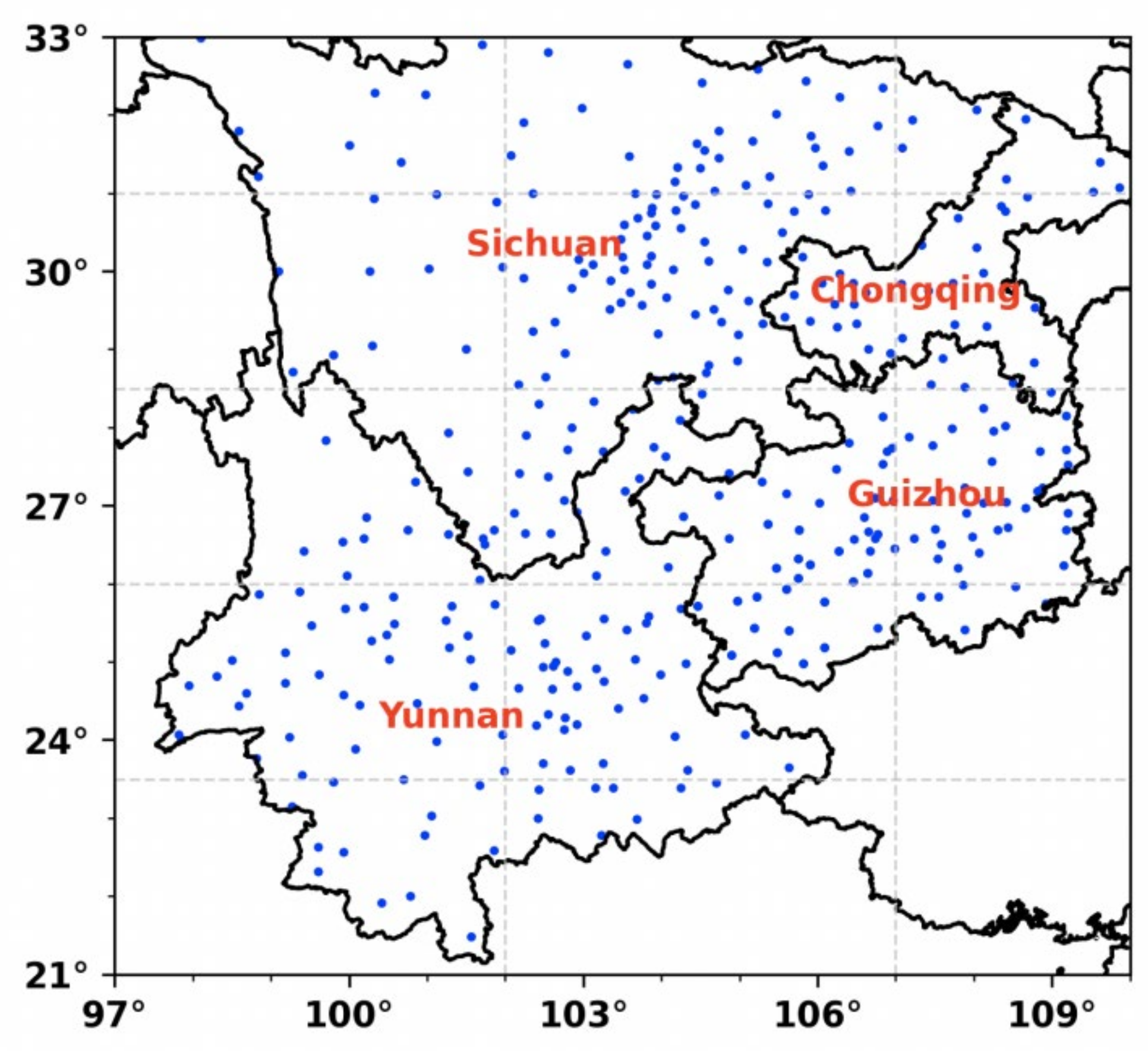
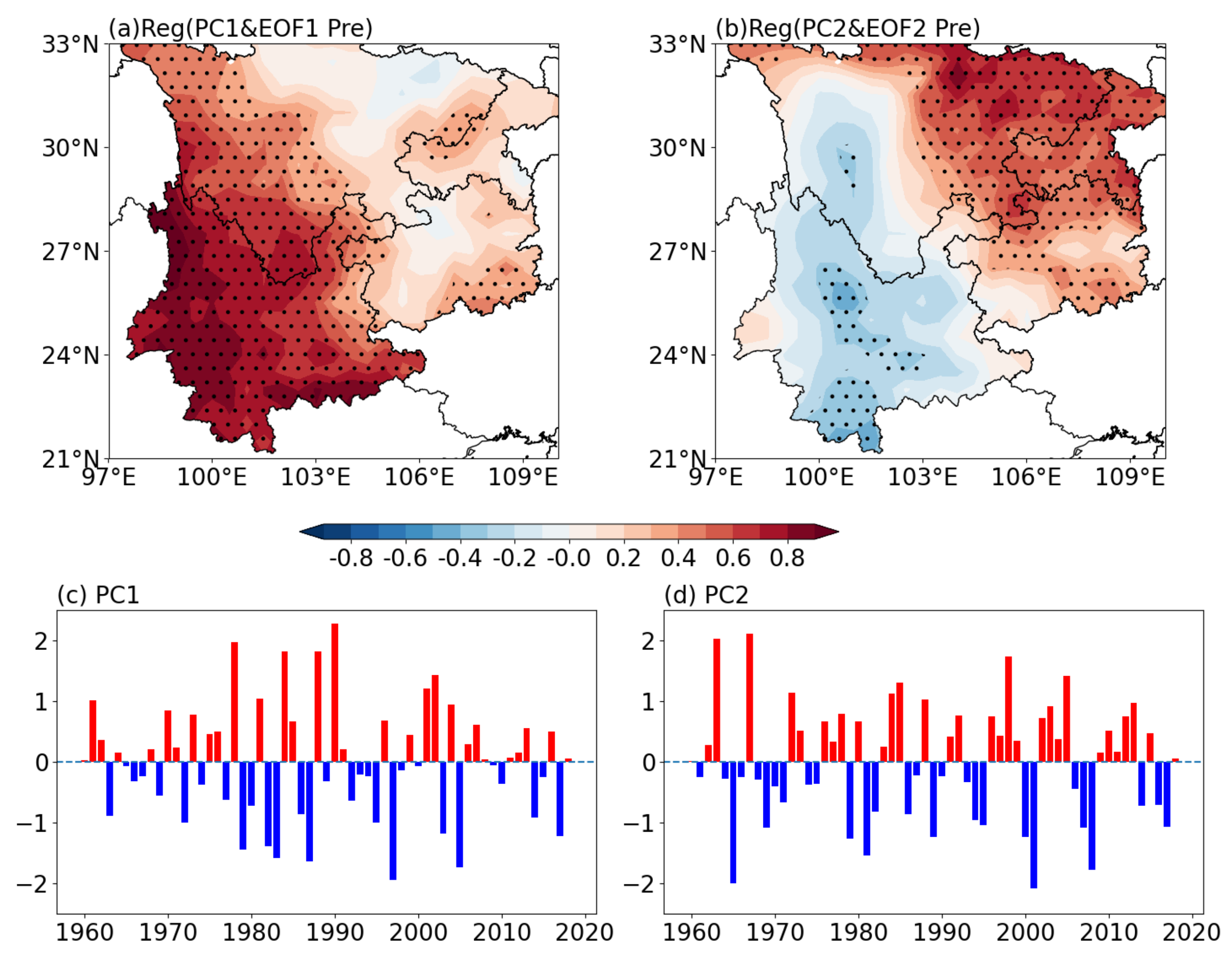
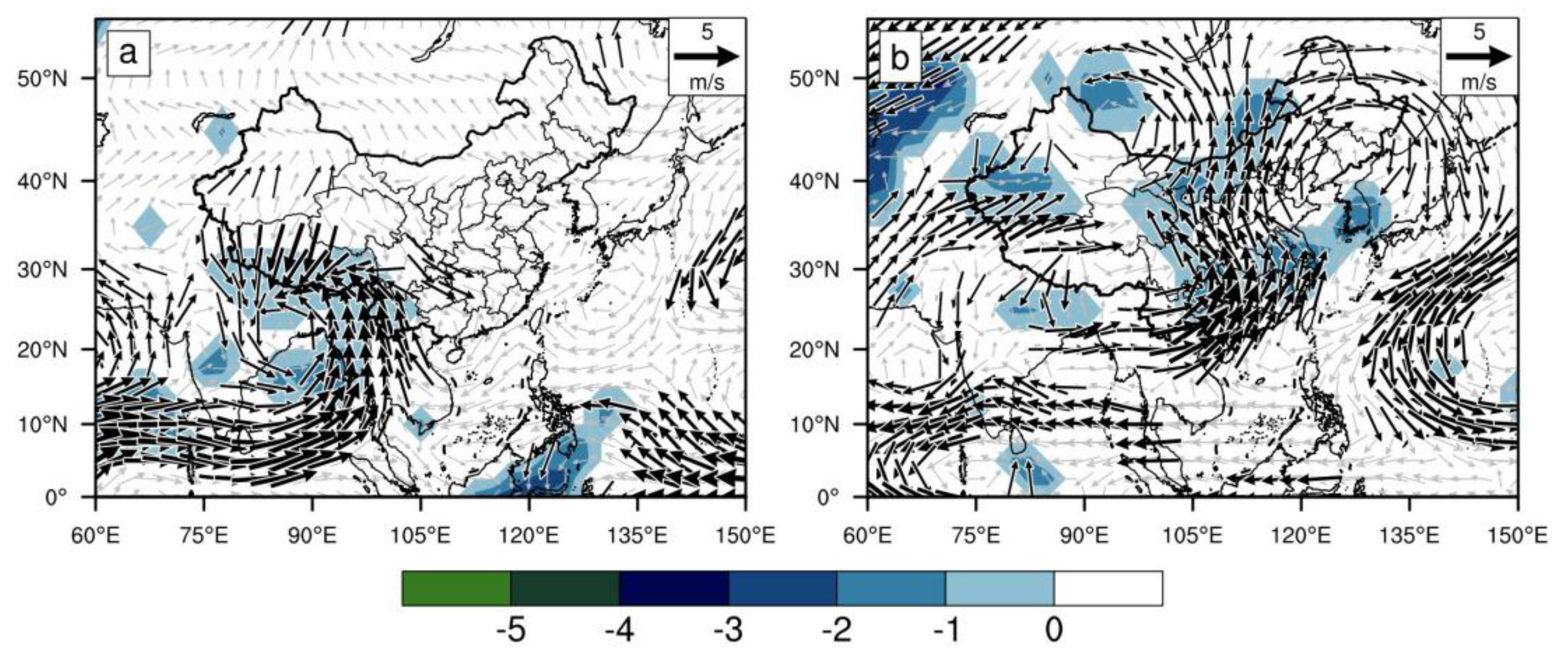
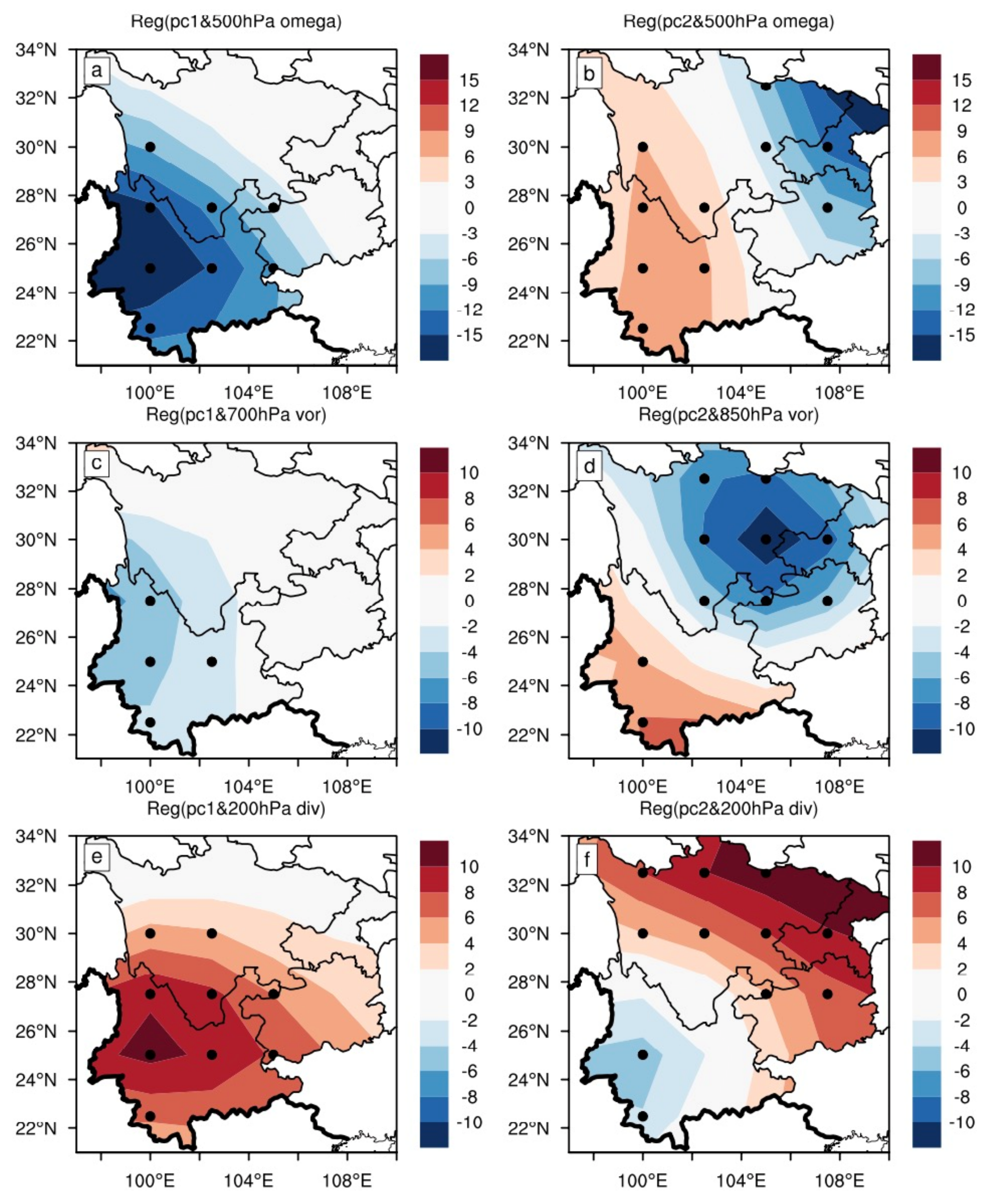
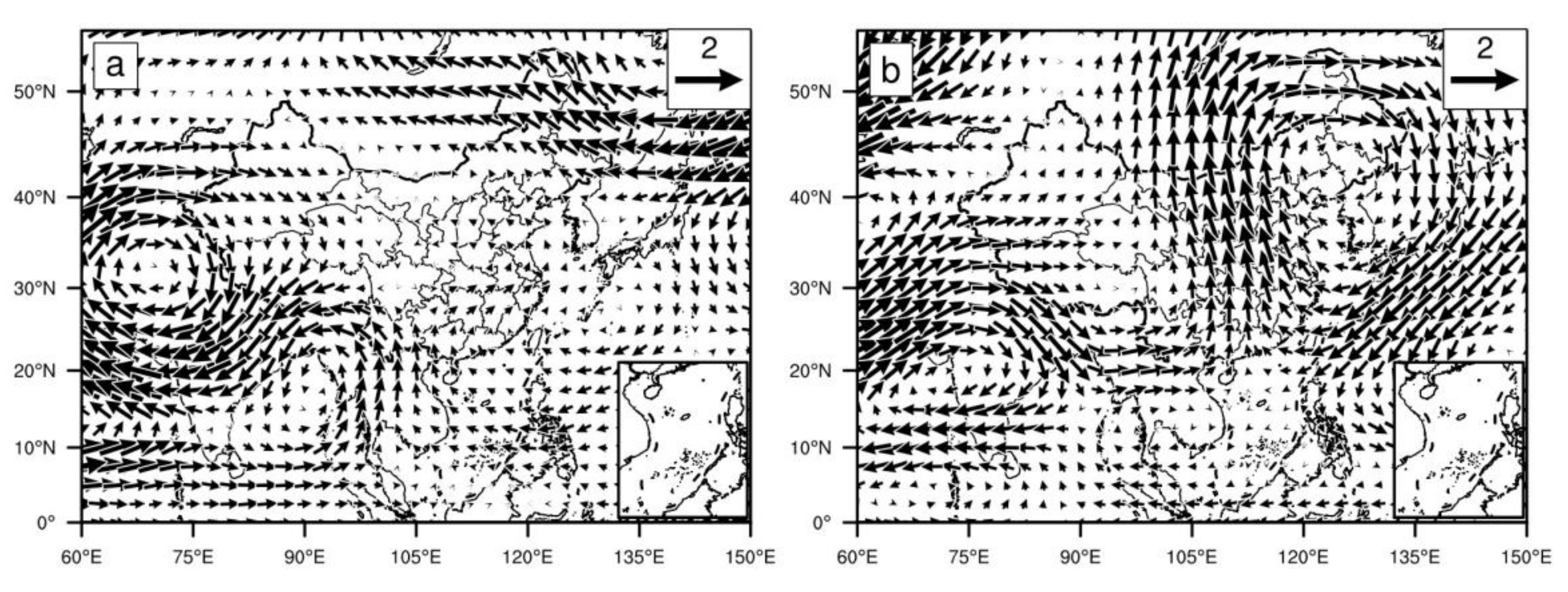
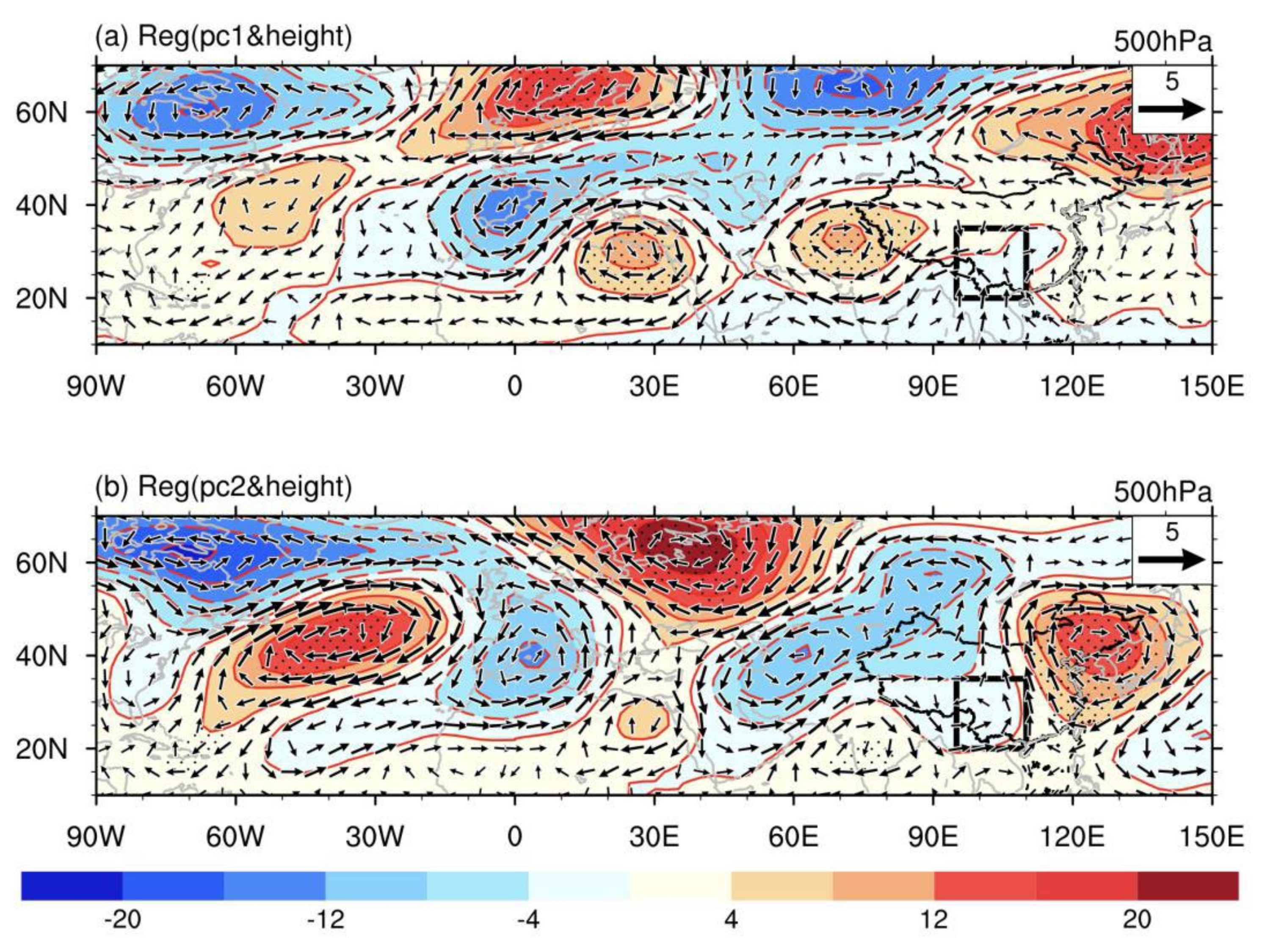
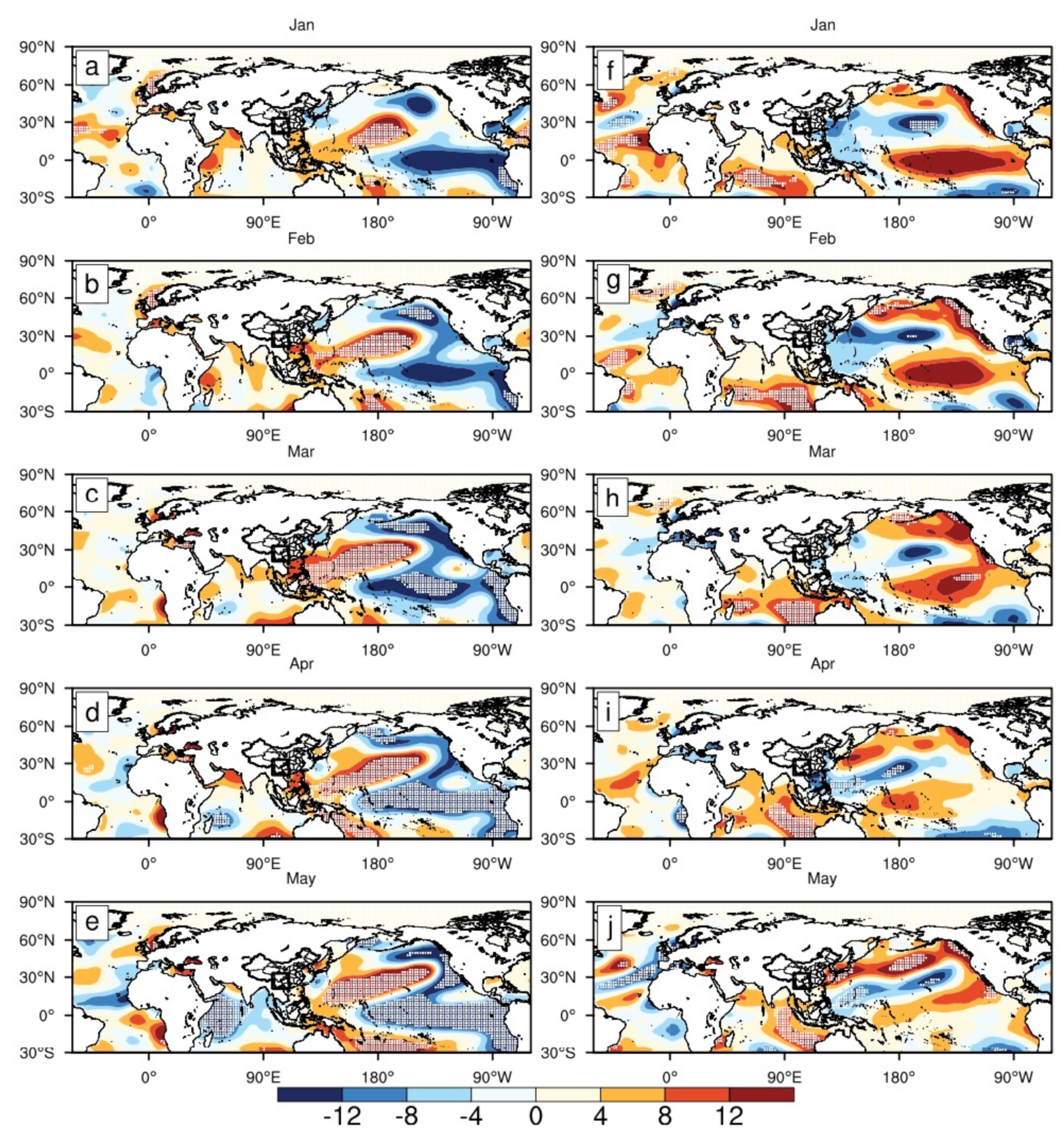
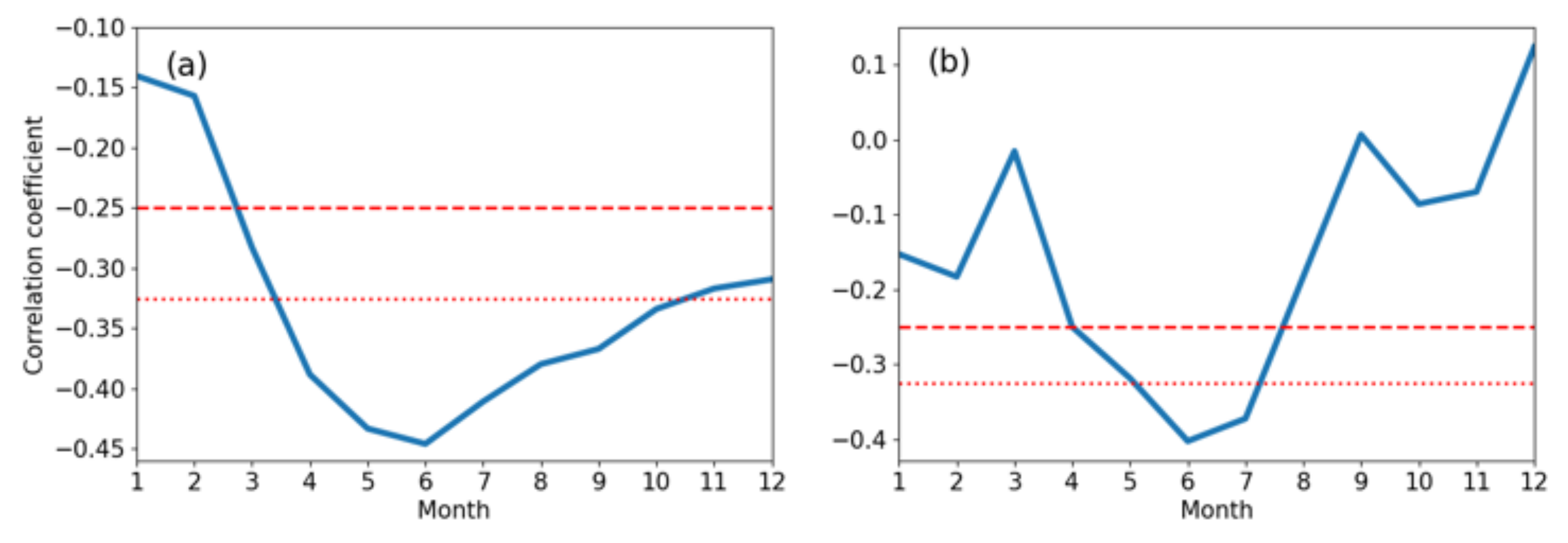
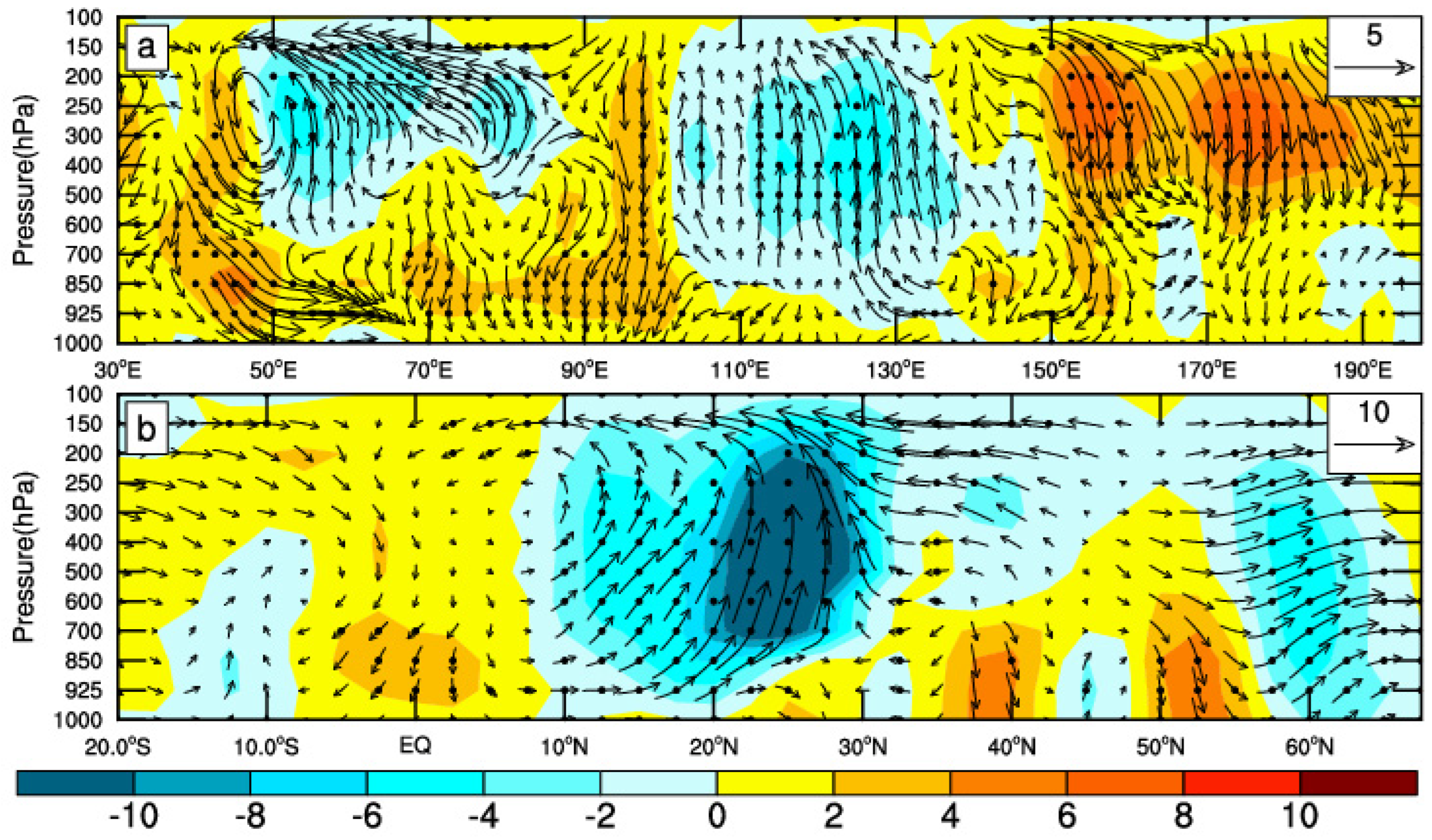
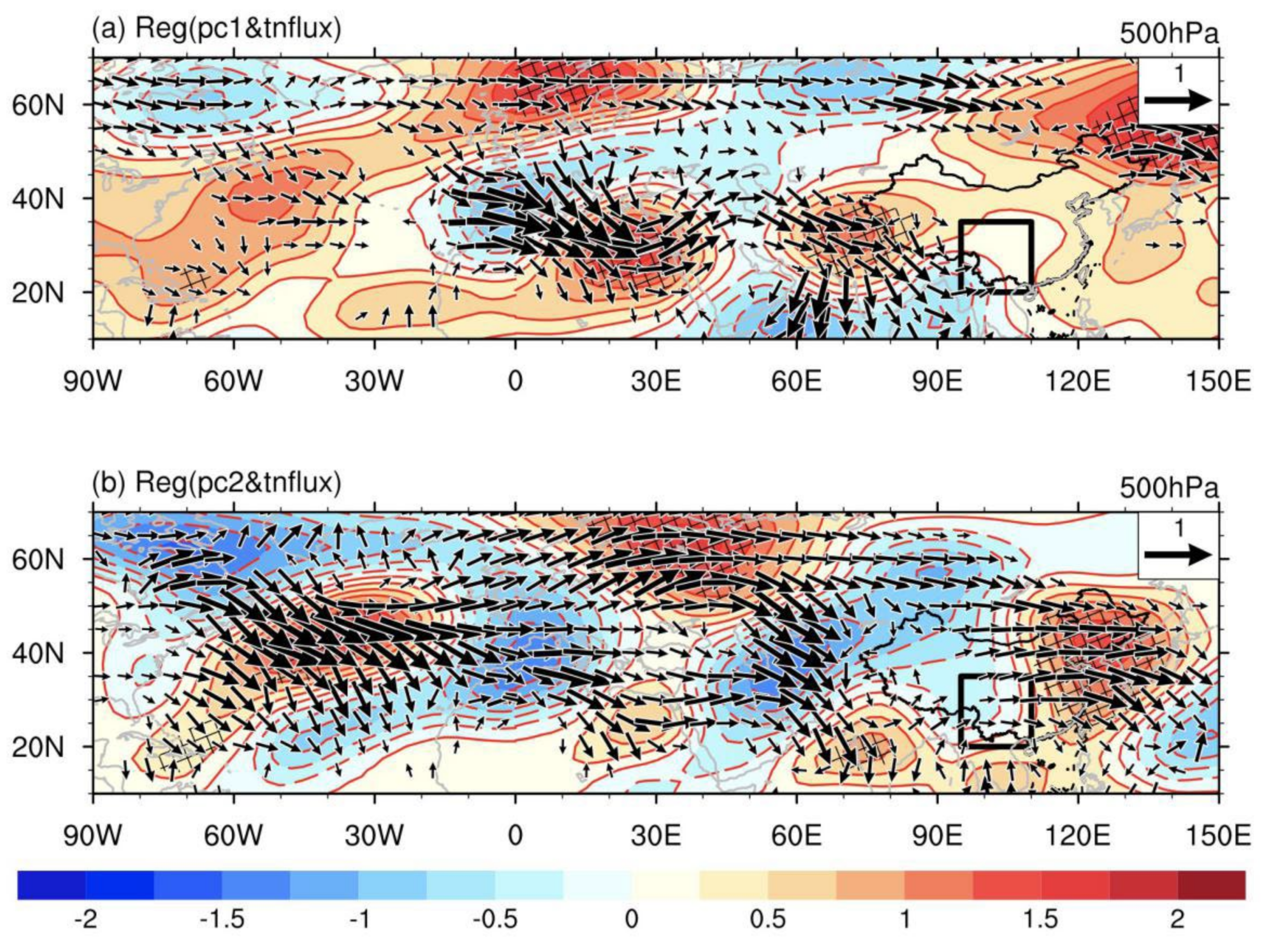
Publisher’s Note: MDPI stays neutral with regard to jurisdictional claims in published maps and institutional affiliations. |
© 2022 by the authors. Licensee MDPI, Basel, Switzerland. This article is an open access article distributed under the terms and conditions of the Creative Commons Attribution (CC BY) license (https://creativecommons.org/licenses/by/4.0/).
Share and Cite
Mei, S.; Chen, S.; Li, Y.; Aru, H. Interannual Variations of Rainfall in Late Spring over Southwest China and Associated Sea Surface Temperature and Atmospheric Circulation Anomalies. Atmosphere 2022, 13, 735. https://doi.org/10.3390/atmos13050735
Mei S, Chen S, Li Y, Aru H. Interannual Variations of Rainfall in Late Spring over Southwest China and Associated Sea Surface Temperature and Atmospheric Circulation Anomalies. Atmosphere. 2022; 13(5):735. https://doi.org/10.3390/atmos13050735
Chicago/Turabian StyleMei, Shuangli, Shangfeng Chen, Yong Li, and Hasi Aru. 2022. "Interannual Variations of Rainfall in Late Spring over Southwest China and Associated Sea Surface Temperature and Atmospheric Circulation Anomalies" Atmosphere 13, no. 5: 735. https://doi.org/10.3390/atmos13050735
APA StyleMei, S., Chen, S., Li, Y., & Aru, H. (2022). Interannual Variations of Rainfall in Late Spring over Southwest China and Associated Sea Surface Temperature and Atmospheric Circulation Anomalies. Atmosphere, 13(5), 735. https://doi.org/10.3390/atmos13050735






